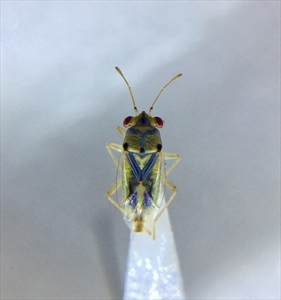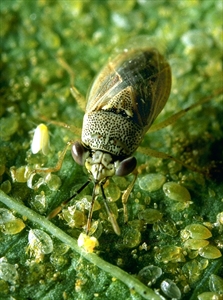Big-eyed bug
Pacific Pests, Pathogens, Weeds & Pesticides - Online edition
Pacific Pests, Pathogens, Weeds & Pesticides
Big-eyed bug (370)
Geocoris species. There are at least 140 species.
Oceania: big-eyed bugs are reported from Australia and Fiji.
Many kinds of insects are prey, including aphids, leafhoppers, lygus bugs (mirids), mealybugs, thrips, all stages of whiteflies, and the eggs and early-stage larvae of moths. It also attacks mites. The bug is an important predator of cotton pests, e.g., Helicoverpa species (corn earworm and tobacco budworm).
In Fiji, it is reported by Swaine (1971)1 to be "the main enemy of the lantana bug, Teleonemia scruplosa, which was introduced ... from Hawaii for the control of this noxious weed".
The bug is an important predator that hunts for many kinds of insect pests, eggs, nymphs and adults smaller than themselves, as well as mites, that occur in turf, ornamentals and agricultural crops. Eggs are laid singly or in clusters on leaves or stems near potential prey. After hatching, the nymphs pass through five stages before becoming adults, and this takes about 30 days at 25°C, longer at lower temperatures.
Both nymphs (similar to adults but smaller and without wings) and adults are predators, but they can survive on nectar, pollen and honeydew when prey is scarce. They also feed on seeds, e.g., sunflower. Adults live about one month, and during this time the female lays 150-300 eggs.
Big-eyed bugs are about 5-6 mm long, oval, somewhat flattened, broad heads and bulging eyes - a distinguishing characteristic (Photos 1&2). They have piercing-sucking (needle-like) mouthparts used to stab their prey, injecting enzymes, and sucking out the juices.
Geocoris interact with other biological control agents; they attack Orius (minute pirate bugs), and are themselves attacked by lacewings, assassin bugs and spiders. Also, their eggs are parasitised by a scelionid wasp in the USA.
The bug is effective as a predator and studies have shown that nymphs can eat as many as 1600 spider mites before reaching adulthood, while adults have been reported consuming as many as 80 per day. Studies have also found that these bugs are effective in greenhouse crops. Although big-eyed bugs can survive by feeding on plants, they do not cause significant injury.
Look for fast moving bugs, 5-6 mm long, grey, brown or yellowish, with long needle-like mouthparts, broad heads and very large eyes. Generally, they occur in low-growing plants of field crops. Look for the forewings, one crosses over the other, forming a triangular pattern pointing towards the rear of the insect (Photo 1).
Studies have shown that cover crops, e.g., crimson clover and vetch assist populations of the bug in North America. To take advantage of this, cash crops are interplanted with the clover, and as the clover dies the bugs migrate into the cash crops. Whether this is likely to occur in the wet tropics is not clear. Another suggestion is to plant sunflowers to sustain populations of the bug when prey populations are low.
It is important to preserve populations of Geocoris by avoiding the use of broad spectrum pesticides; instead, test the usefulness of biopesticides: (i) microbial pesticides in which a bacterium, fungus or virus is the active ingredient [e.g., spinosad, Bt (Bacillus thuringiensis), Beauvaria bassiana]; (ii) botanical pesticides (neem, garlic); (iii) biochemical pesticides e.g., sex pheromones that attract insects to traps; or, and where permitted; and (iv) plant-incorporated protectants, i.e., plants that are genetically modified to produce substances that kill insects (e.g., Bt proteins) .
Interestingly, Geocoris punctipes showed no ill-effects either indirectly when feeding on pests reared on cotton and maize genetically engineered to contain Bt proteins, or directly through plant feeding.
AUTHORS Grahame Jackson & Mani Mua
1Information from Swaine G (1971) Agricultural Zoology in Fiji. Her Majesty's Stationery Office. London; and Mead FW (2017) Geocoris spp. Featured Creatures, Entomology & Nematology. UF/IFAS, University of Florida. (http://entnemdept.ufl.edu/creatures/beneficial/bigeyed_bugs.htm); and Geocoris spp. Biological control. Cornell University, College of Agriculture and Life Sciences. (https://biocontrol.entomology.cornell.edu/predators/Geocoris.php); and from Hooks CR et al. Big-eyed bug: A MVP of generalist natural enemies. Department of Entomology, University of Maryland. (https://extension.umd.edu/sites/extension.umd.edu/files/_docs/programs/mdvegetables/Geocoris.pdf). Photo 2 Jack Dykinga, ARS image gallery, USDA.
Produced with support from the Australian Centre for International Agricultural Research under project HORT/2016/185: Responding to emerging pest and disease threats to horticulture in the Pacific islands, implemented by the University of Queensland and the Secretariat of the Pacific Community.





